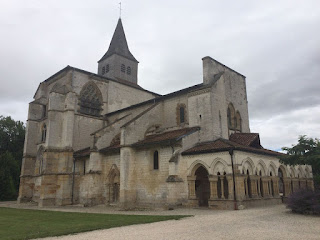Finally, after what seemed like a herculean struggle, we slipped our lines a little after 9 am and entered the River Somme.
The river itself is not very long, arising in the hills above the city of Saint Quentin about 250 k from the sea. Small craft navigated almost to the headwaters as early as the middle ages but it wasn’t until 1843 that the canal was opened to commercial shipping as far as Saint Quentin. Never very busy, the main products shipped were salt, grain, wood, coal and wine. The canal generally follows the bed of the river and there are many lakes alongside resulting from the digging of peat, used as fuel as late as the early 20th century. Peat was also responsible for the wealth of the region in that era, resulting in small villages with big churches and chateaus.
Of course, the river is also famous as the site of the killing or wounding of over 1.2 million soldiers during the WW I Battle of the Somme in the summer and fall of 1916. The area is scattered with numerous cemeteries and memorials
The upper reaches, from St. Simon to the Canal du Nord have been closed to navigation for a number of years and while there has been some talk of reopening the waterway, so far there’s been no action. In 1991 The Somme Department (generally equivalent to a state in the US) took over operation of the lower portion of the canal from the national VNF and has operated it as a separate navigation since then. They are doing a very fine job.
The first hint that this was not a VNF waterway was at the very first lock. The eclusier was there to assist us, handing us a detailed chart of the river showing the many stopping places, many with water and electricity, and the estimated travel time between each one. She operated the lock for us and then sped off in one of the bright orange cars that we would become very familiar with to be ready to operate the next two locks and two opening bridges we would clear before we reached our first stopping place, the village of Cappy. By lunchtime we were tied up in a very pleasant mooring in Cappy’s city park, near a former hire boat base, now a municipal marina.
We’re all the way down behind that big barge.
The lock just downstream of the village with the church in the background.
There is also a very nice mooring just above this lock, as there were at almost all the locks and bridges.
Cappy is a beautiful village but a little down on it’s luck. With the closure of the hireboat base a few years ago there’s really nothing there. The restaurant we wanted to go to had closed but there was a boulangerie so all was not lost. The whole river is a popular tourist area with lots of summer homes and holiday camps and there were several of both in town.
Saturday morning we set off through the lifting bridge and lock at Cappy, motoring easily downstream to the next major town, Corbie. We passed many beautiful mooring spots along the way, making careful notes as we’d be coming back through in a couple weeks.
The locks and bridges were all a breeze. We’d been provided a phone number for the central control office in Amien. All we had to do when we started out for the day was give them a call and let them know where we were and which way we were headed. A very helpful eclusier would be waiting for us at the lock or bridge and, if they weren’t following us to the next lock, they would telephone ahead to their colleague to let them know we were coming. We never had to wait more than a few minutes for a lock or bridge. Except of course at lunch. Things shut down between 12:30 and 1:30.
We pulled into Corbie a little after lunch. We’d stay the rest of the afternoon and Sunday, heading off for Amien on Monday morning.
The massive 18th century Abbey church of St. Pierre. Who is that not-so-massive person in the blue raincoat?
The church kinda dwarfs the architecture around it.
Corbie’s city hall. It started out as a private chateau built in the 1860’s by the Baron Caix de Saint Aymour, but was bought by the village in 1923.





















































